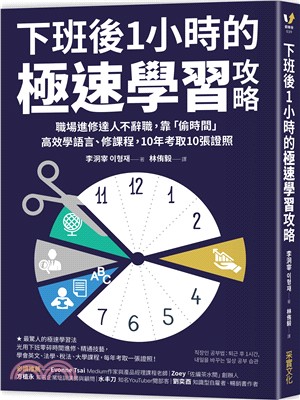管理溝通雙語教程(簡體書)
- 系列名:“十二五”普通高等教育規劃教材·經管系列
- ISBN13:9787302366713
- 出版社:清華大學出版社(大陸)
- 作者:任志霞
- 裝訂/頁數:平裝/362頁
- 規格:23.5cm*16.8cm (高/寬)
- 出版日:2014/09/01
商品簡介
本書可作為高等院校經濟管理類專業本科生、研 究生,以及MBA、EMBA相關課程的學習教材,也可作 為企業經營管理者的培訓參考用書。
目次
Chapter 1 Introduction to Management Communication Introduction Section 1: Defining Communication 1.Communication 2.Management Communication 3.Importance of Communication in an Organization Section 2: Communication Process 1.Communication Process 2.Means of Communication Section 3: Communication Flows in an Organization 1.The Levels of Communication 2.Communication Flow in Organizations Section 4: Communication Barriers 1.Communication Barriers 2.Overcoming Communication Barriers Part One: Case Study Part Two: Class Practice Part Three: Discussion Questions Part Four: Further Reading Reference Chapter 2 Communication Strategy Introduction Section 1: Communicator Strategy 1.What is Your Objective? 2.What Communication Style do You Choose? 3.What is Your Credibility? Section 2: Audience Strategy 1.Who are They? 2.What do They Know and Expect? 3.What do They Feel? 4.How Can You Motivate Them? Section 3: Message Strategy 1.Emphasize Your Conclusion 2.Organize Your Message Section 4: Channel Choice Strategy 1.Written Channels 2.Oral-only Channels 3.Blended Channels Section 5: Culture Strategy Part One: Case Study Part Two: Class Practice Part Three: Discussion Questions Part Four: Further Reading Reference Chapter 3 Listening and Feedback Introduction Section 1: Defining Listening 1.To be a Good Listener is not Easy 2.Defining Listening 3.Listening is a Process Section 2: Barriers of Listening 1.Barriers of Listening 2.Ten Worst Listening Habits Section 3: Effective Listening 1.Effective Listening 2.Suggestion for Effective Listening Section 4: Feedback in Listening 1.Power of Feedback 2.Vital Components to the Feedback 3.Giving and Receiving Feedback Part One: Case Study Part Two: Class Practice Part Three: Discussion Questions Part Four: Further Reading Reference Chapter 4 Speaking Introduction Section 1: Defining Speaking 1.People Often Fear Before Making Presentations 2.How to Overcome the Fears 3.The Process of Speaking 4.Elements of Speaking 5.Purposes for Speaking Section 2: How to Structure Speaking 1.Preparing What to Say 2.Preparing Your Notes 3.Questions and Answers 4.Other Speaking Situations Section 3: Skills of Effective Speaking 1.Do Speak up.Don’t Mumble 2.Do be Brief.Don’t Talk on and on about Your Points 3.Do Look at Your Listeners.Don’t Avoid Looking at Your Listeners 4.Do Organize Your Points.Don’t Ramble 5.Do Use Visual Aids When Appropriate.Don’t Rely Only on Speaking 6.Do Use Natural Gestures.Don’t be Stiff 7.Do Maintain a Comfortable Pace.Don’t Rush or Dawdle 8.Do Vary Your Volume, Pitch, and Tone.Don’t Talk without Showing or Expression 9.Do Use Pauses Effectively.Don’t Stop and Start 10.Do Listen.Don’t Ignore Your Listeners’ Gestures or Comments Part One: Case Study Part Two: Class Practice Part Three: Discussion Questions Part Four: Further Reading Reference Chapter 5 Negotiation Introduction Section 1: Defining Negotiation 1.What is Negotiation? 2.Bargain and Negotiation 3.Characters of Negotiation 4.Stages of Negotiation Section 2: The Principle of Negotiation 1.The History and Development of Principled Negotiation 2.Principled Negotiation Section 3: Negotiation Strategy 1.The System for Negotiation Goal 2.Four Common Strategies 3.Characteristics of Different Engagement Strategies Section4: The Skills of Successful Negotiation 1.Preparing for a Successful Negotiation 2.Style is Critical 3.Emotion is Important 4.Finding a Fair Compromise 5.Negotiating Successfully 6.Six Common Pitfalls to Avoid Part One: Case Study Part Two: Class Practice Part Three: Discussion Questions Part Four: Further Reading Reference Chapter 6 Interview Introduction Section 1: Defining Interview 1.What is Interview? 2.Interview Styles Section 2: Job Interview 1.Before Interview 2.During Interview 3.After Interview Section 3: Skills of Successful Interview 1.Manners of Interview 2.Answer Skills Part One: Case Study Part Two: Class Practice Part Three: Discussion Questions Part Four: Further Reading Reference Chapter 7 Writing Introduction Section 1: Defining Writing 1.What is Writing? 2.Writing Types 3.Writing Process Section 2: Principles of Writing Section 3: Skills of Writing Section 4: Business Letters 1.What is a Business Letter? 2.Types of Business Letter 3.How to Write a Business Letter Part One: Case Study Part Two: Class Practice Part Three: Discussion Questions Part Four: Further Reading Reference Chapter 8 Organizational Communication Introduction Section 1: Defining Organizational Communication 1.Historical Trends and the Increasing Importance of Organi Communication 2.Theoretical Perspectives 3.Key Functions of Organizational Communication Section 2: Internal Organizational Communication 1.Benefits of Internal Communication 2.Common Causes of Problems in Internal Communications 3.Key Principles to Effective Internal Organizational Communications 4.Key Distinctions to Support Effective Internal Communications Section 3: External Organizational Communication 1.Public Relations 2.Media Relations 3.Reputation Management Section 4: Making Successful Organizational Communication Communication Strategies, Systems, and Skills Part One: Case Study Part Two: Class Practice Part Three: Discussion Questions Part Four: Further Reading Reference Chapter 9 Meeting Introduction Section 1: Defining Meeting Section 2: When and How to Organize a Meeting 1.When to Call a Meeting? 2.How to Organize a Meeting Section 3: Skills of Organizing Meeting 1.Chose the Suitable Meeting Style 2.Some Useful Meeting Tips Part One: Case Study Part Two: Class Practice Part Three: Discussion Questions Part Four: Further Reading Reference Chapter 10 Nonverbal Communication Introduction Section 1: Defining Nonverbal Communication 1.What is Non-verbal Communication? 2.The Relation between Verbal and Nonverbal Communication Section 2: Function of Nonverbal Communication Section 3: Types of Non-verbal Communication Section 4: Use Nonverbal Communication Successfully Part One: Case Study Part Two: Class Practice Part Three: Discussion Questions Part Four: Further Reading Reference Chapter 11 Cross-cultural Communication Introduction Section 1: Defining Cross-cultural Communication 1.What is a Culture? 2.What is a Communication? 3.What is a Cross-cultural Communication? Section 2: Functions of Cross-cultural Communication Section 3: Barriers of Cross-cultural Communication 1.Physical Barriers 2.Emotional Barriers 3.Perceptual Barriers 4.Cultural Barriers 5.Language Barriers 6.Gender Barriers Section 4: Strategy of Cross-cultural Communication 1.Know Yourself and Your Own Cultural Context 2.Know Your Audience and Match the Message to Their Commu Needs and Styles 3.Respect English Language Barriers 4.Be Mindful of the Whole Message you are Sending 5.Respect Your Audience and Suspend Judgment 6.Use Active Listening and Check for Understanding 7.Act Authentically 8.Don’t Spring Surprises Part One: Case Study Part Two: Class Practice Part Three: Discussion Questions Part Four: Further Reading Reference Chapter 12 Conflict Management And Communication Introduction Section 1: Defining Conflict 1.A Definition of Conflict 2.Transitions in Conflict Views 3.Classification of Conflicts 4.Sources of Conflict in Organizations Section 2: Analysis of Conflict Process Section 3: Strategies and Techniques of Conflict Management 1.A Definition of Conflict Management 2.Steps to Manage Conflict 3.Strategies of Conflict Management 4.Techniques of Conflict Management Part One: Case Study Part Two: Class Practice Part Three: Discussion Questions Part Four: Further Reading Reference
主題書展
更多主題書展
更多書展本週66折
您曾經瀏覽過的商品
購物須知
大陸出版品因裝訂品質及貨運條件與台灣出版品落差甚大,除封面破損、內頁脫落等較嚴重的狀態,其餘商品將正常出貨。
特別提醒:部分書籍附贈之內容(如音頻mp3或影片dvd等)已無實體光碟提供,需以QR CODE 連結至當地網站註冊“並通過驗證程序”,方可下載使用。
無現貨庫存之簡體書,將向海外調貨:
海外有庫存之書籍,等候約45個工作天;
海外無庫存之書籍,平均作業時間約60個工作天,然不保證確定可調到貨,尚請見諒。
為了保護您的權益,「三民網路書店」提供會員七日商品鑑賞期(收到商品為起始日)。
若要辦理退貨,請在商品鑑賞期內寄回,且商品必須是全新狀態與完整包裝(商品、附件、發票、隨貨贈品等)否則恕不接受退貨。

























